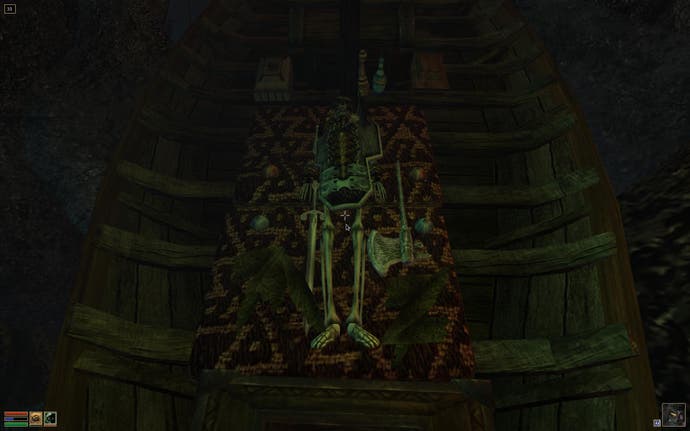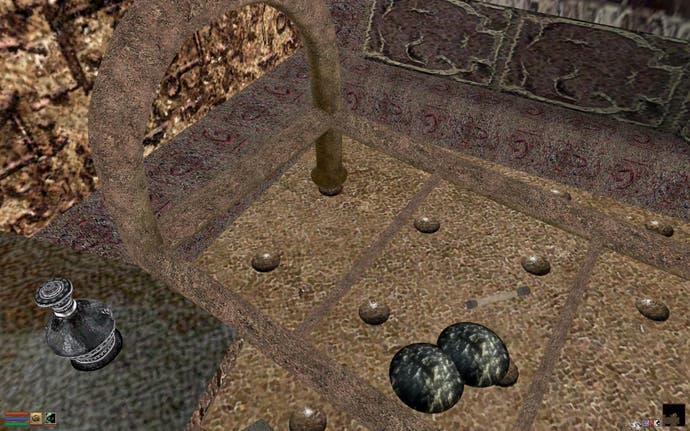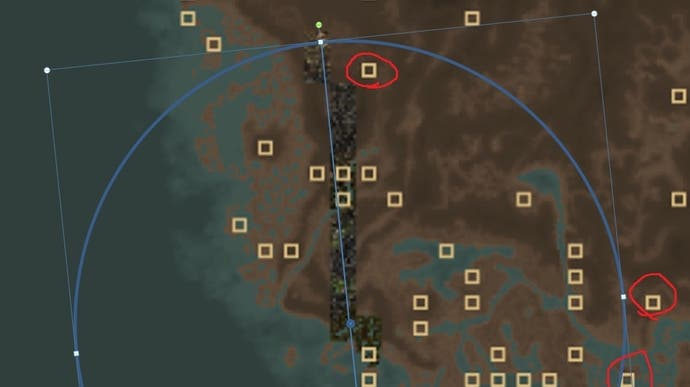The hidden secrets of The Elder Scrolls 3: Morrowind
Secret skooma.
The Elder Scrolls is one of the most illustrious sagas in video game history, which is perhaps why Skyrim has been ported to everything short of a calculator over the last eight years. However, although Skyrim and its predecessor Oblivion are vast oceans containing a wealth of wonderfully intricate curios, their oft-overlooked older sibling Morrowind is a bottomless lake, its boundless depths plummeting into the territories of magic, secrecy, and the unknown.
Since Morrowind launched in 2002, players have been exploring its every nook and cranny, desperately seeking to unravel its most intimately hidden secrets. Perhaps the most accomplished of these Morrowind mystery hunters is Redditor OccupyTamriel, who has discovered countless hidden treasures buried in Morrowind's deepest recesses.
"I started playing Elder Scrolls when a very dear friend of mine told me about the series," OccupyTamriel tells me. "I needed a lot of time to get used to Morrowind - the sheer complexity of the world and the mechanics, the invisible per-attack dice roll, and just being lost and making no progress were extremely off-putting."
However, the setting, the music, and the lore always dragged OccupyTamriel back, until eventually something clicked. Since that click, OccupyTamriel has pumped over 2000 hours into Bethesda's iconic RPG, rummaging through its most esoteric parts in order to scavenge for secrets that would never be found otherwise.
"I probably started hunting for secrets when the game didn't have anything else to offer," OccupyTamriel explains. In their words, this happened after finishing the main quest, exhausting all the side content, and playing through Morrowind's expansions multiple times.
"The fantastic communities on Reddit were a huge motivation and major driver to search for these," OccupyTamriel says, "because what fun is it to discover things without sharing them?" OccupyTamriel also mentions they owed it to the developers, who put their heart and soul into Morrowind: "Just imagine how disgruntled they'd be if no one ever found their secrets!"
One such hidden curiosity is embedded in an item called Sottilde's Code Book. When OccupyTamriel realised how detailed Morrowind truly was during one of their many adventures across Vvardenfell, they became convinced the words and letters in Sottilde's Code Book couldn't just be recorded in some arbitrary sequence. After all, it's emphatically called a Code Book, they explain.
OccupyTamriel continues, informing me they've always been a sucker for symbolism, puzzles and encrypting. "Luckily - since I'm lazy - there's an online tool to encode and decode vigenère cipher," OccupyTamriel says. After some trial and error, they cracked the code, learning about the eponymous Sottilde's shady skooma dealing, cleverly and carefully hidden beneath a layer of inconspicuous cryptography.

Another secret OccupyTamriel discovered had to do with an NPC named Tarhiel, a Bosmer Enchanter whose body may be found north of Seyda Neen. When exploring the area around Seyda Neen, to the north Tarhiel can be seen flying up in the air, yelling "WAAAAAAAOOOOOOOOOOAAAAAAAAAGGGHHHHHH!!!!!" He soon falls to the ground and dies upon impact. Tarhiel's uncanny ability to "fly" comes from the Scrolls of Icarian Flight, which allow the caster to leap great distances in the air. "I just had to learn more about this fella," OccupyTamriel tells me.
After messing around with Tarhiel's Scrolls of Icarian Flight, OccupyTamriel studied his journal and began their investigation. You can read about their wild, but solid conclusions here. "Some of it is conjecture," OccupyTamriel says, "but there is so much pointing to Caldera being his starting place."
Among the other secrets OccupyTamriel unearthed are their successful endeavour to investigate the hauntings in Vvardenfell, the unravelling of the debt-collecting Orcs in Caldera, and the discovery of the Sword of White Woe in Balmora. They also found a "Naughty Dwemer" in Bamz-Amschend, who was burnt to ash as karma for being a cheeky eavesdropper.
However, my favourite secret in Morrowind has to do with a meticulously well-hidden Nordic tomb that's home to the remains of an unknown warrior who was laid to rest on a boat alongside their dragonscale armour.
I became so enraptured by this tomb that I hunted down its designer: ex-Bethesda environmental artist/location builder Mark Bullock.
"I started at Bethesda somewhere in late 1999 or early 2000," Bullock explains, before joking about the likely inaccurate resume he used to land the gig. It wasn't long before Bullock took over level design responsibilities on top of his own work, mostly for dungeons and interior locations, and began working with the narrative department to ensure that locations and lore were coherent.
During his run on Morrowind, Bullock was involved in realising a range of locations, designing assets for structures like the Lighthouse of Seyda Neen, The Governor's Mansion of Caldera and the Dragon Statue found at the harbour of Ebonheart. When he eventually moved on to House Telvanni Architecture, and was gifted newfound creative freedom, the cogs of his imagination spun out of control, to the extent that he couldn't include everything he wanted in his designs.
One such example is related to the towers at the centre of Telvanni structures. "[They were] the source for all the living buildings surrounding [them]," Bullock explains. "They were biological runners and extensions of the tower itself. And because of this relationship, the lord of any tower could, in effect, cut off a tendril, so if some unfortunate individual crossed the leader, they could find their home slowly withering away. Or, if the system was dynamic enough, perhaps even thrashing about, like a dying creature."
Bullock also delved deeply into the etymology of the Daedra, who, according to him, "aren't diabolical within the usual sense of Christian demon-like creatures." They're of a different realm, and aren't naturally born from Nirn. "I wanted to give a sense that the structures were indeed both very old and also incompatible with the reality of Tamriel," he says.

This brings us to the Nordic tomb, the awe-inspiring reason I reached out to OccupyTamriel and Bullock in the first place.
"Honestly, it was a momentary flash, a picture in my head of a series of walls surrounding a central structure," Bullock explains. "Maybe some Piranesi, mixed with the overview of Labyrinth. I could never have enough reference."
Bullock was only about half an hour away from Downtown D.C. while working on Morrowind, which meant he had easy access to Smithsonian exhibitions and some "fantastic" non-mainstream bookstores. "I was probably on the Mall every other weekend," he says, "hitting my favourite museums with their exhibits - the Sackler housed all sorts of wonderful things - and most of all their bookstores. My reference library was growing by 3-10 volumes a month."
Despite his academic background, Bullock drew from a range of pop culture, such as "The Dark Crystal, Legend, Labyrinth, ANYTHING Miyazaki, and of course Star Wars".
"Popular fantasy and science fiction were always present [too]," Bullock adds. "Tolkien, Moorcock, Wolfe, Cook, Herbert - similarly, contemporary artists such as Wayne Barlowe and Beksinski, and the classical German Romanticists were having a tremendous influence on me at the time.
"Also, nothing beats going to the actual source material itself, so the Sumerian, Akkadian and other Mesopotamian epics, the Hindu and Sanskrit literature, the Sagas, the Book of the Dead, Talmudic and Biblical writings, Chinese literatures...the list goes on."

Naturally, when it came to actually designing the mysterious Nordic tomb, there were too many ideas swirling around in Bullock's head at the time for him to recall which exact influences he drew from now. Also, he was pressed for time when completing the tomb, and it never really occurred to him that he was making something that would be considered a hidden secret. "It was simply another place in the world I wanted to make as cool and interesting as I could within a narrow allotment of time," he says. "Probably a day."
However, Bullock does remember why he opted to make this particular funerary chamber Nordic. "I wanted something to refer to the Nord period of occupation," he tells me, "and of how to reflect [that] a culture, having moved into a new territory, begins to make some adaptations and 'borrowings' from the local culture.
"Also, I wanted something to evoke a certain degree of wonder, different both from what players would find in the world, but also unexpected from their assumptions of what a Nord tomb would be."
This is where things get a little wild. In order to make this burial place sincerely Nordic, Bullock incorporated ideas from all across history and mythology: "Scythian burial mounds, cyclopean megaliths, legendary Chinese tombs, Egyptian funerary structures and customs - all these are playing their role at some level," he explains. "I won't pretend I spent a great deal of time contemplating the location, it was simply quickly realised inspiration. I am pleased and more than a little surprised with some of the player reactions to it I learned of later."
Bullock also left other treasures, like Daedric armour, dotted all across Vvardenfell, "for players who really were going to take the time to explore every nook and cranny," he says. "I think that was the extent of any conscious thought of 'hiding a surprise.' "

Although Bullock was dedicated to imbuing all of his creations with a sense of purpose and, on occasion, a secret waiting to be unravelled, he reckons there's no fixed way Bethesda hides secrets in their games, "in the sense that there is a [specific] formula or design doctrine." According to him, it boils down to mixing "an imaginative, inspiring milieu with extremely talented and passionate team members".
"And because almost everyone had this holistic understanding of the world," Bullock says, "it was less about 'hiding' a character, artifact, or location, and more about what is the story of this thing, which makes it feels right and correct in the world."
The beauty of mystery goes two ways. "I don't know of anyone who worked on an Elder Scrolls title, and Morrowind in particular, who has not felt it getting under the skin," Bullock tells me. "It becomes a world which must be created for the pure reason that it exists. I know it sounds pretentious as hell, but that really was the way of it for many."
Bullock even started to incorporate aspects of his own life into his design. In a tomb with funerary skulls pierced with Silver Daggers, where a spectre appears if you're courageous enough to remove one, an NPC named Mordrin Hannin can be found. "[This] was the name of my first Morrowind character I had to create in order to play-test the game, and that of an old D&D character of mine," Bullock says. "There's a bit of random trivia."
After hearing all of this, it's no wonder that OccupyTamriel maintains they've "never played a game that felt so alive".
"Oblivion and Skyrim are absolutely amazing games as well," OccupyTamriel continues, "but speaking of game design philosophy, they can't even hold a candle to Morrowind. Not because Oblivion and Skyrim felt rushed or overly automated, but just because Morrowind is that perfect. Morrowind will always be my favourite game."
And when you truly delve into Morrowind's sublime secrets and chat about the nitty-gritty imbued in them with someone involved with their realisation, you can clearly see why that's the case.










